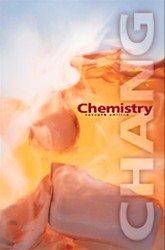Test Bank This manual contains over
2000 multiple choice and short-answer questions. The questions, which are graded
in difficulty, are comparable to the problems in the text and include multi-step
problems that require conceptual analysis. MicroTest Computerized Test
Bank This test bank contains
all of the questions in the print Test Bank along with algorithms and over 200
algorithms-based questions that instructors can edit to create their own test
templates. This supplement is available in Windows and Macintosh versions. Instructor's Manual by Brandon J. Cruickshank
(Northern Arizona University), Daryl Doyle (GMI/Engineering and Management Institute),
and Raymond Chang. This complete manual for teaching a general chemistry course
based on Chemistry contains a brief summary of the contents of each chapter,
along with learning goals and references to background concepts in earlier chapters.
Following this material is a complete listing of the more challenging problems
in the chapter, and the problems that are worked out in detail in the Student
Solutions Manual. The solutions to all of the end-of-chapter problems are then
given, including those that are in the Solutions Manual. Some of the end-of-chapter
Review Questions are also answered. Finally, this resource contains discussion
questions and tips, information on relevant applications, and references to
other elements of the text package. Overhead Transparencies Approximately 250 full-color
text illustrations are reproduced on acetate for overhead projection. Chang Animations by Brandon Cruickshank (Northern
Arizona University). These twenty-eight animations are interactive and specifically
support content and concepts in Chemistry. Icons in the text show which concepts
are animated. Animations can be used by both instructors and students on the
OnLine Learning Center, Essential Study Partner, e-Source, and in the Animations
Visual Resource Library. Chemistry Animations Visual
Resource Library organized by Eric Johnson
(Ball State University). This instructor CD-ROM allows you to use animations
in your classroom in the way that works best for you. This multi-CD set includes
over 150 animations that can be played directly from the CD or can be imported
easily into your own lecture presentation. The animation library is fully searchable,
and many animations are included at full-screen size. Visual Resource Library
(VRL) This instructor CD-ROM contains
electronic files of all full-color images (illustrations and photographs) from
the text and is designed to help you create visually exciting presentations.
The Visual Resource Library allows you to incorporate selected images into word
processing programs to use as distribution material for students. Picture labels
can be easily removed. In addition, this tool provides prearranged chapter-by-chapter
PowerPoint presentations. PowerPoint Lecture Presentation by J. David Robertson (University
of Missouri). Instructors who adopt Chemistry will find that this presentation
not only saves time but also enables them to create visually stunning lecture
presentations. The web-based PowerPoint lecture includes notes for the entire
course, visuals from the seventh edition, and animations embedded at appropriate
points in the program. Use this complete lecture outline, or revise the lecture
to fit your own course. Online Learning Center Website
(OLC) Log on at http://highered.mcgraw-hill.com/sites/00736556011/ This comprehensive, book-specific
website offers excellent tools for both the instructor and the student. Instructors
can create a more interactive course with the integration of this site, and
a secured Instructor Center stores your essential course materials to save you
prep time before class. This center also offers PowerPoint lecture outline,
additional narratives for Chang animations, and more. Media Integration Guide By Scott S. Perry (University
of Houston). The guide explains what media is available, and describes how to
use media effectively during lecture and outside of the classroom. WebCT By Renee Cole and Steve
Boone (Central Missouri State University). Instructors who use WebCT will love
the WebCT specific course content we offer with Chemistry. The WebCT
course includes the complete Test Bank formatted for easy WebCT use;
reading quizzes; On-line homework with detailed feedback; interactive study
guide; and current topics questions. Course-Specific PageOut Designed specifically to
help you with your individual course needs, PageOut will assist you in integrating
your syllabus with Chemistry and state-of-the-art new media tools.
At the heart of PageOut you'll find integrated multimedia, a full-scale Online
Learning Center, and an Integration Guide discussing technology in the classroom.
More than 20,000 professors have chosen PageOut to create customized course
websites. It's incredibly easy to use, and it's FREE to instructors who use
a McGraw-Hill textbook in any of their courses. Primis LabBase by Joseph Lagowski (The
University of Texas at Austin). More than 40 general chemistry experiments are
available in this database collection of general chemistry lab experiments from
the Journal of Chemical Education and experiments used by Professor Lagowski
at the University of Texas at Austin, allowing instructors to customize their
lab manuals. Cooperative Chemistry Laboratory
Manual by Melanie Cooper (Clemson
University). This innovative guide features open-ended problems designed to
simulate experience in a research lab. Working in groups, students investigate
one problem over a period of several weeks, so that they might complete three
or four projects during the semester, rather than one pre-programmed experiment
per class. The emphasis here is on experimental design, analysis problem solving,
and communication. | 



